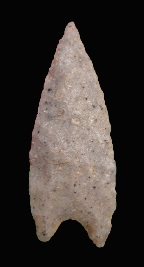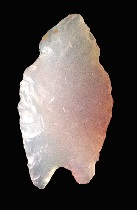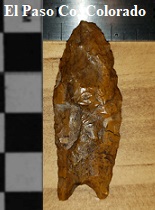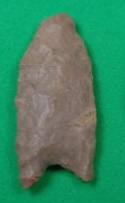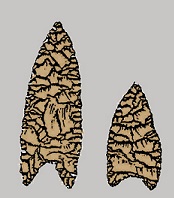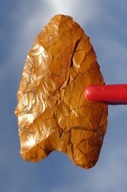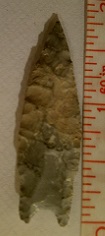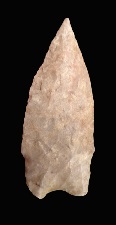Outline is Representative of Size and Shape:

Name Details:
Identified By: Richard P. Wheeler
Named For:
Date Identified: 1952
Type Site: Multiple sites at Keyhole Reservoir, northeastern Wyoming
Identified By: Richard P. Wheeler
Named For:
Date Identified: 1952
Type Site: Multiple sites at Keyhole Reservoir, northeastern Wyoming
Point Validity:
Valid type
Wheeler is a eminent anthropologist who was instrumental in promoting our understanding of Plains archaeology. He conducted extensive studies into Plains archaeology and Canadian archaeology. This type was named in a professional publication and has many professional references. This is considered a valid type.
Wheeler is a eminent anthropologist who was instrumental in promoting our understanding of Plains archaeology. He conducted extensive studies into Plains archaeology and Canadian archaeology. This type was named in a professional publication and has many professional references. This is considered a valid type.
McKean Lanceolate
Southsider Var. (see below)AKA: McKean Shouldered
Cluster: McKean Cluster
Description of Physical Characteristics and Flaking Pattern:
This is a medium lanceolate point with an elliptical or median ridge cross section. Some examples may have a flattened cross section. The blade has an excurvate outward with the widest point of the blade being about halfway. The base may vary from slightly concaved to concaved or notched. This point was manufactured with random percussion flaking with finishing well controlled pressure flaking forming a flaking pattern that ranges from random to collateral (most commonly) to oblique transverse flaking.
Size Measurements:
Total Length - 35 to 61 mm (51 mm average), Max Width - 14 to 21 mm (17 mm average), Basal Width - 11 to 13 mm (12 mm average), Thickness - 8 to 10 mm, Basal Concavity - 2 to 6 mm (4 mm average) (Wheeler, 1952).
Total Length - 35 to 61 mm (51 mm average), Max Width - 14 to 21 mm (17 mm average), Basal Width - 11 to 13 mm (12 mm average), Thickness - 8 to 10 mm, Basal Concavity - 2 to 6 mm (4 mm average) (Wheeler, 1952).
Commonly Utilized Material:
Various locally available materials
Various locally available materials
Additional Comments:
This complex has five main points associated with it and two variations. The McKean point, Southsider variation, Duncan Point, Hanna Point, Hanna Northern variation, Mallory, and the Yonkee point.
A slight variation of the McKean Lanceolate is the Southsider Lanceolate. This variation has a slight lateral edge restriction which gives the point an appearance, but does not quite qualify for, a side notched point (Drager and Irelans, 1986). This sub-type was identified at the Southsider Cave (48BH363), Wyoming.
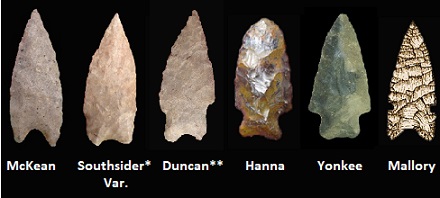
* Southsider Var. represents continuum between the McKean and Duncan point. This type is commonly typed as a McKean or Duncan depending on the degree of lateral edge restriction. Also called Shouldered McKean.
** The Duncan point is also referred to as Shouldered McKean
This complex has five main points associated with it and two variations. The McKean point, Southsider variation, Duncan Point, Hanna Point, Hanna Northern variation, Mallory, and the Yonkee point.
A slight variation of the McKean Lanceolate is the Southsider Lanceolate. This variation has a slight lateral edge restriction which gives the point an appearance, but does not quite qualify for, a side notched point (Drager and Irelans, 1986). This sub-type was identified at the Southsider Cave (48BH363), Wyoming.

* Southsider Var. represents continuum between the McKean and Duncan point. This type is commonly typed as a McKean or Duncan depending on the degree of lateral edge restriction. Also called Shouldered McKean.
** The Duncan point is also referred to as Shouldered McKean
Distribution: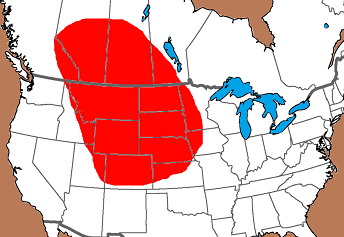

Distribution Comments:
This point is a plains point that is primarily found on the Northern Plains. It is found most commonly in Canada, it has been found into Idaho, Utah, Colorado, and Nebraska. It is rarely found on the Colorado Plateau, and is not found in the Great Basin. Morrow (2016) reports this type as rarely found in Minnesota and Iowa. Bell (1958) rarely places this point into northwestern Oklahoma.
This point is a plains point that is primarily found on the Northern Plains. It is found most commonly in Canada, it has been found into Idaho, Utah, Colorado, and Nebraska. It is rarely found on the Colorado Plateau, and is not found in the Great Basin. Morrow (2016) reports this type as rarely found in Minnesota and Iowa. Bell (1958) rarely places this point into northwestern Oklahoma.
Age / Periods:
Date: 4,500 - 3,500 B.P.
Cultural Period: Middle Archaic
Glacial Period: Neoglacial
Environmental: Sub-Boreal
Culture:
Date: 4,500 - 3,500 B.P.
Cultural Period: Middle Archaic
Glacial Period: Neoglacial
Environmental: Sub-Boreal
Culture:
Age Details:
McKean points are seen to be diagnostic of the McKean phase (ca. 3000 to 1500 B.C.E.) (Morrow, 2016).
McKean points are seen to be diagnostic of the McKean phase (ca. 3000 to 1500 B.C.E.) (Morrow, 2016).
Similar Points:
Alder, Allen, Angostura, Firstview, Fourth of July, Fredrick, Goshen, Green River, Humboldt, Lovell, Meserve, Milnesand, Midland, Plainview
Alder, Allen, Angostura, Firstview, Fourth of July, Fredrick, Goshen, Green River, Humboldt, Lovell, Meserve, Milnesand, Midland, Plainview
Other points in this cluster / Related / Associated Points:
Duncan, Hanna, Hanna Northern, Mallory, Yonkee
Duncan, Hanna, Hanna Northern, Mallory, Yonkee


